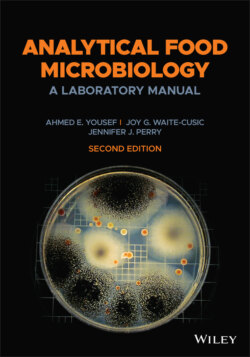Читать книгу Analytical Food Microbiology - Ahmed E. Yousef - Страница 14
Biosafety Levels
ОглавлениеThe health authorities in the US have created a publication regarding biosafety in microbiological and biomedical laboratories (see the reference listed at the end of this chapter). This manual sets forth guidelines for best practices for four biosafety levels. Each biosafety level has a particular set of protocols that laboratory users must follow to minimize risks to the laboratory workers and the public. There are protocols for primary containment (protection of individual workers) and secondary containment (protection of the public). The protocols provide guidance on laboratory security, laboratory practice and technique, required safety precautions, facility design and construction, and required training of supervisors and workers, as well as specific information regarding animal facilities, clinical facilities, and transportation of materials. The publication also contains listings of specific organisms and their assignment to risk groups (RG) with their recommended biosafety level. The following is a brief description of the four biosafety levels.
Biosafety level 1 (BSL‐1)Appropriate for handling agents (RG‐1) that are not known to cause disease and are well characterized; examples include Bacillus subtilis and non‐pathogenic Escherichia coli.Required protective devices include doors, sinks for handwashing, easily cleaned work surfaces, screened windows, and bench tops that are impervious to water.No special construction or ventilation is required.Primary barriers (lab coat and gloves) are required.
Biosafety level 2 (BSL‐2)Appropriate for handling moderate‐risk agents (RG‐2). These include agents associated with human disease, but for which immunization or antibiotic treatment is available; examples include Salmonella and Measles virus.All precautions for BSL‐1 are observed, plus doors must be lockable and marked with biohazard signs, eyewash station is available, air does not recirculate to non‐laboratory areas, and autoclave is available.Special work areas (e.g., biosafety cabinets) should be assigned for activities that might generate aerosols or splashing and for handling large volume or high concentration of organisms.
Biosafety level 3 (BSL‐3)Appropriate for handling agents that may cause serious and potentially lethal infections (RG‐3). These include agents that are transmittable by aerosols. Examples of these agents are Mycobacterium tuberculosis and St. Louis encephalitis virus.All precautions for BSL‐2 are observed plus separate facility or zone with double door entry; inward only airflow with 10–12 air changes/hour; water‐resistant walls, floors, and ceilings; filtered vacuum lines; and respiratory protection may be required.
Biosafety level 4 (BSL‐4)Appropriate for handling exotic agents (RG‐4) that (a) pose high risk of life‐threatening diseases, (b) are transmittable by infectious aerosols, and (c) for which no treatment is available. An example of these agents is Ebola virus.All precautions for BSL‐3 are observed plus single‐pass dedicated air system; walls, ceilings, and floors create an internal seal; all liquid effluent and solid waste are decontaminated; entry doors cannot be opened simultaneously; communication system; emergency generator, positive pressure personnel suit, and showering upon exit are required.
Note: Food microbiology laboratories that accommodate pathogen work are classified as BSL‐2.
